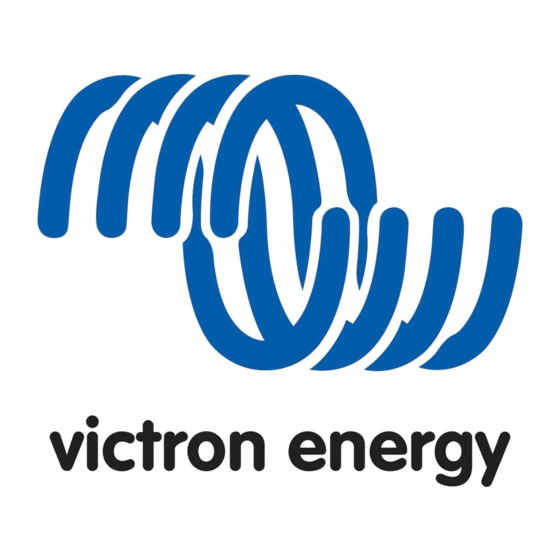
Advertisement
Quick Links
Advertisement

Summary of Contents for Victron energy Lynx Ion + Shunt 350
- Page 3 VICTRON ENERGY PRODUCTS DESCRIBED HERE IN. Victron Energy B.V. reserves the right to revise and improve its products as it sees fit. This publication descr bes the state of this product at the time of its publication and may not...
- Page 5 Transport and storage On storage or transport of the product, ensure that the battery leads are disconnected. No liability can be accepted for damage in transit if the equipment is not transported in its original packaging. Store the product in a dry environment; the storage temperature should range from –20°C to 60°C.
- Page 6 DESCRIPTION System components • One or more 24V 180Ah Lithium-Ion batteries. • The Lynx Power In. A modular dc bus-bar. • The Lynx Ion + Shunt is the battery management system (BMS) that controls the batteries. A 350/600 Ampere safety relay is inside the Lynx Ion + Shunt. •...
-
Page 7: Led Indications
LED INDICATIONS Lynx Ion + Shunt LED indications Firmware version 1.22 and higher. Status LED state Description System is in standby mode. Press START button to start up the system Blinking fast Initialization. Running Blinking Balancing active Flashing/beeping 1 time Battery initialization error Flashing/beeping 2 times No batteries connected... - Page 8 Battery LED indications Battery status LED State Description BMS Running Toggle slow Balancing / BMS stopped Toggle fast BMS Error Battery BMSCAN-Bus error LED State Description No error in CAN-Bus Single flash CAN-Bus passive error CAN-Bus bus-off Battery BMS CAN-Bus status LED State Description CAN-Bus operational...
- Page 11 Connection of the BMS CAN-Bus network To connect the BMS CAN-Bus communication network you will need: • CAT5 cable with RJ45 connectors • Two termination resistors (supplied with the Lynx Ion + Shunt) Procedure Use connection A of the Lynx Ion + Shunt, top left pair of RJ45 connectors. Connect the other end of the CAT5 cable to the first battery.
- Page 13 Using the I/O of the Lynx Ion + Shunt Allow-to-charge and allow-to-discharge The most important contacts are ‘allow-to-charge’ and ‘allow-to-discharge’. These are used to control loads and chargers based on the battery state of charge. These contacts are potential free, and normally open. They are closed when the system is normally working.
- Page 16 CONFIGURING A MULTI OR QUATTRO The Multi is controlled by the Lynx Ion + Shunt, via the allow-to-charge and allow-to- discharge contacts. State of Charge 100% The batteries are discharged too low. The 350A safety contactor in the Lynx Ion will open. The batteries are discharged.
- Page 17 Configure the Lynx-Ion BMS Support assistant as follows:...
-
Page 18: First Power Up
FIRST POWER UP Other than below procedure, no configuration is needed. The battery configuration is automatically recognized. Power up procedure Make sure that all energy consumers are switched off before starting up the system. The Lynx Ion + Shunt will pre-charge the system before closing the safety contactor. -
Page 19: Temperature Protection
TEMPERATURE PROTECTION The Lynx Ion + Shunt constantly monitors the battery temperatures, and protects them according below rules. In case the temperature is outside the limits, it will first signal the chargers and/or loads via the allow-to-charge and allow-to-discharge contacts. It will open the safety contactor if there is no response. -
Page 20: Maintenance
MAINTENANCE The Lynx Ion + Shunt does not require specific maintenance. It will suffice to check all connections once a year. Avoid moisture and oil/soot/vapors, and keep the device clean. - Page 21 TECHNICAL SPECIFICATIONS LYNX ION + SHUNT More details about power consumption are in section 1.3.2. Supplyvoltagerange 9 ... 60VDC Supplypower Standbymode 73mW @ 26,2V and 138mW @ 52,4V Active mode 8,7 W Operatingtemperaturerange 0 ... 50 C Main safety contactor 350A or 600A DC continuous (depends on Lynx Ion + Shunt type) Potential free contacts...
- Page 22 10 TECHNICAL SPECIFICATIONS BATTERIES Victron Lithium-Ion Battery 24V / 180Ah Technology Lithium-Iron Phosphate (LiFePo4) Nominal voltage 26,4 V Nominal capacity 180 Ah Nominal power 4,75 KWh Power / Weight ratio 86 Wh/Kg Charge/Discharge Charge cut-off voltage at 0,05C 28,8 V Discharge cut-off voltage 20 V Recommended charge/discharge current (0,3C)
- Page 24 Front view...
- Page 26 APPENDIX B: INSIDE THE LYNX ION + SHUNT Part descriptions Safety contactor. 350A or 600A continuous. Pre-Charge fuse 10A. Mounting holes.
- Page 27 APPENDIX C: THE LITIUM-ION BATTERY Front Front Part descriptions Connection and status panel. ‘+’ battery connection ‘-’ battery connection Battery power LED Battery status LED BMS CAN-Bus connections BMS CAN-Bus error LED BMS CAN-Bus status LED...
- Page 29 Distributor: Serial number: Version : Date 10 June 2014...







Need help?
Do you have a question about the Lynx Ion + Shunt 350 and is the answer not in the manual?
Questions and answers